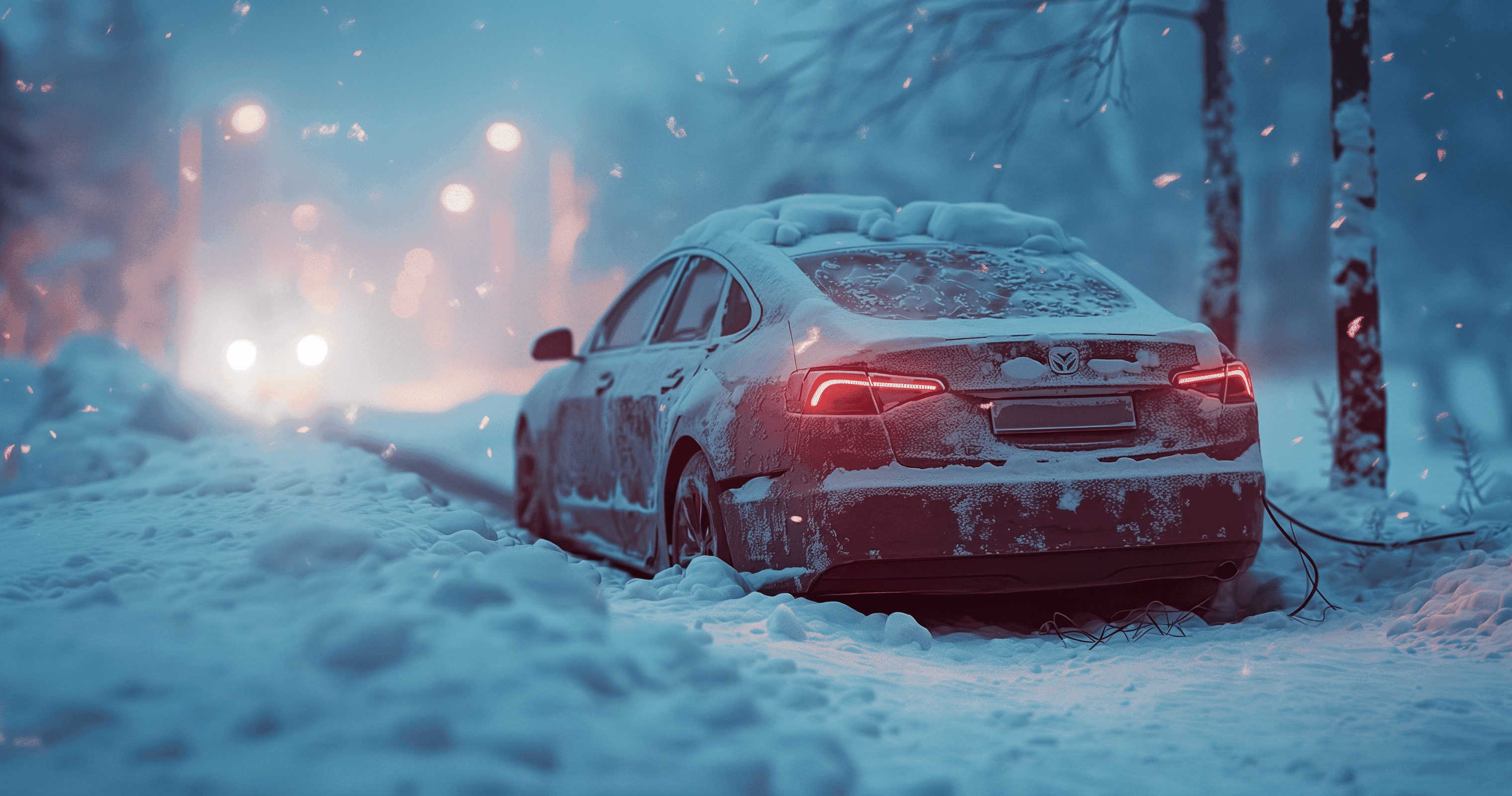How to Winterize Your Car: Prepare for Cold Weather Driving
Oct 11, 2024
Be better prepared to handle whatever the winter weather throws your way, ensuring both safety and reliability on the road.
Subscribe to our newsletter
Subscribe to our newsletter


This is a post from AIM Insurance
As winter approaches, it’s essential to ensure your car is ready for the colder months ahead. Winterizing your vehicle can prevent breakdowns and keep you safe on icy roads. Here are the key steps to winterize your car:
1. Inspect Your Tires
Switch to Winter Tires: Winter tires provide better traction on snow and ice. They’re made with special rubber compounds that stay flexible in cold temperatures, improving grip.
Check Tire Pressure: Cold weather can cause tire pressure to drop, so check it regularly to ensure optimal performance.
Monitor Tread Depth: Make sure your tires have enough tread depth to handle snowy conditions. The minimum safe depth is 4/32 of an inch.
2. Test Your Battery
Battery Health: Cold weather can reduce your battery’s ability to start the car. Have your battery tested, especially if it’s more than a few years old, to ensure it has enough power.
Check Connections: Make sure battery terminals are clean and free from corrosion.
3. Top Off and Replace Fluids
Antifreeze: Ensure your coolant system has the right mixture of antifreeze and water (usually 50/50) to prevent freezing.
Oil Change: Consider switching to a winter-grade oil that flows better in cold temperatures.
Windshield Washer Fluid: Use a winter-specific windshield washer fluid that won’t freeze in subzero conditions.
4. Check Brakes
Brake Inspection: Winter roads can be slippery, so ensuring your brakes are in top condition is critical. Have them inspected for wear, and replace brake pads or rotors if needed.
5. Prepare for Visibility
Windshield Wipers: Install winter wiper blades that can handle snow and ice more effectively. Check that your current wipers aren’t worn out.
Defroster and Heater: Test your defroster and heater to make sure they work properly, keeping your windshield clear and the interior warm.
6. Lights and Visibility
Check Headlights and Taillights: Ensure all exterior lights are working correctly and replace any dim or burnt-out bulbs.
Fog Lights: If you have fog lights, make sure they’re functioning properly for better visibility in foggy or snowy conditions.
7. Pack an Emergency Kit
Winter Essentials: Prepare an emergency kit that includes essentials such as a blanket, flashlight, extra batteries, first-aid supplies, jumper cables, a snow brush, an ice scraper, and non-perishable snacks. These items can be invaluable if you get stranded in a snowstorm.
8. Inspect Belts and Hoses
Cold Stress: Cold weather can cause rubber belts and hoses to become brittle and crack. Inspect them for any signs of wear and replace them if necessary.
By taking these steps to winterize your car, you’ll be better prepared to handle whatever the winter weather throws your way, ensuring both safety and reliability on the road.
Find out more about AIM Insurance here
Join The Burlington Club

Trending Posts

Join The Burlington Club

Trending Posts

How to Winterize Your Car: Prepare for Cold Weather Driving
Oct 11, 2024
Be better prepared to handle whatever the winter weather throws your way, ensuring both safety and reliability on the road.
Subscribe to our newsletter
Subscribe to our newsletter


This is a post from AIM Insurance
As winter approaches, it’s essential to ensure your car is ready for the colder months ahead. Winterizing your vehicle can prevent breakdowns and keep you safe on icy roads. Here are the key steps to winterize your car:
1. Inspect Your Tires
Switch to Winter Tires: Winter tires provide better traction on snow and ice. They’re made with special rubber compounds that stay flexible in cold temperatures, improving grip.
Check Tire Pressure: Cold weather can cause tire pressure to drop, so check it regularly to ensure optimal performance.
Monitor Tread Depth: Make sure your tires have enough tread depth to handle snowy conditions. The minimum safe depth is 4/32 of an inch.
2. Test Your Battery
Battery Health: Cold weather can reduce your battery’s ability to start the car. Have your battery tested, especially if it’s more than a few years old, to ensure it has enough power.
Check Connections: Make sure battery terminals are clean and free from corrosion.
3. Top Off and Replace Fluids
Antifreeze: Ensure your coolant system has the right mixture of antifreeze and water (usually 50/50) to prevent freezing.
Oil Change: Consider switching to a winter-grade oil that flows better in cold temperatures.
Windshield Washer Fluid: Use a winter-specific windshield washer fluid that won’t freeze in subzero conditions.
4. Check Brakes
Brake Inspection: Winter roads can be slippery, so ensuring your brakes are in top condition is critical. Have them inspected for wear, and replace brake pads or rotors if needed.
5. Prepare for Visibility
Windshield Wipers: Install winter wiper blades that can handle snow and ice more effectively. Check that your current wipers aren’t worn out.
Defroster and Heater: Test your defroster and heater to make sure they work properly, keeping your windshield clear and the interior warm.
6. Lights and Visibility
Check Headlights and Taillights: Ensure all exterior lights are working correctly and replace any dim or burnt-out bulbs.
Fog Lights: If you have fog lights, make sure they’re functioning properly for better visibility in foggy or snowy conditions.
7. Pack an Emergency Kit
Winter Essentials: Prepare an emergency kit that includes essentials such as a blanket, flashlight, extra batteries, first-aid supplies, jumper cables, a snow brush, an ice scraper, and non-perishable snacks. These items can be invaluable if you get stranded in a snowstorm.
8. Inspect Belts and Hoses
Cold Stress: Cold weather can cause rubber belts and hoses to become brittle and crack. Inspect them for any signs of wear and replace them if necessary.
By taking these steps to winterize your car, you’ll be better prepared to handle whatever the winter weather throws your way, ensuring both safety and reliability on the road.
Find out more about AIM Insurance here
The Burlington Club

Trending Posts

The Burlington Club

Trending Posts

Burlington 365.
@burlington365
@burlington365
News
Podcasts
Businesses
Oct 11, 2024
How to Winterize Your Car: Prepare for Cold Weather Driving
Be better prepared to handle whatever the winter weather throws your way, ensuring both safety and reliability on the road.

This is a post from AIM Insurance
As winter approaches, it’s essential to ensure your car is ready for the colder months ahead. Winterizing your vehicle can prevent breakdowns and keep you safe on icy roads. Here are the key steps to winterize your car:
1. Inspect Your Tires
Switch to Winter Tires: Winter tires provide better traction on snow and ice. They’re made with special rubber compounds that stay flexible in cold temperatures, improving grip.
Check Tire Pressure: Cold weather can cause tire pressure to drop, so check it regularly to ensure optimal performance.
Monitor Tread Depth: Make sure your tires have enough tread depth to handle snowy conditions. The minimum safe depth is 4/32 of an inch.
2. Test Your Battery
Battery Health: Cold weather can reduce your battery’s ability to start the car. Have your battery tested, especially if it’s more than a few years old, to ensure it has enough power.
Check Connections: Make sure battery terminals are clean and free from corrosion.
3. Top Off and Replace Fluids
Antifreeze: Ensure your coolant system has the right mixture of antifreeze and water (usually 50/50) to prevent freezing.
Oil Change: Consider switching to a winter-grade oil that flows better in cold temperatures.
Windshield Washer Fluid: Use a winter-specific windshield washer fluid that won’t freeze in subzero conditions.
4. Check Brakes
Brake Inspection: Winter roads can be slippery, so ensuring your brakes are in top condition is critical. Have them inspected for wear, and replace brake pads or rotors if needed.
5. Prepare for Visibility
Windshield Wipers: Install winter wiper blades that can handle snow and ice more effectively. Check that your current wipers aren’t worn out.
Defroster and Heater: Test your defroster and heater to make sure they work properly, keeping your windshield clear and the interior warm.
6. Lights and Visibility
Check Headlights and Taillights: Ensure all exterior lights are working correctly and replace any dim or burnt-out bulbs.
Fog Lights: If you have fog lights, make sure they’re functioning properly for better visibility in foggy or snowy conditions.
7. Pack an Emergency Kit
Winter Essentials: Prepare an emergency kit that includes essentials such as a blanket, flashlight, extra batteries, first-aid supplies, jumper cables, a snow brush, an ice scraper, and non-perishable snacks. These items can be invaluable if you get stranded in a snowstorm.
8. Inspect Belts and Hoses
Cold Stress: Cold weather can cause rubber belts and hoses to become brittle and crack. Inspect them for any signs of wear and replace them if necessary.
By taking these steps to winterize your car, you’ll be better prepared to handle whatever the winter weather throws your way, ensuring both safety and reliability on the road.
Find out more about AIM Insurance here
Join The Burlington Club

Trending Posts


